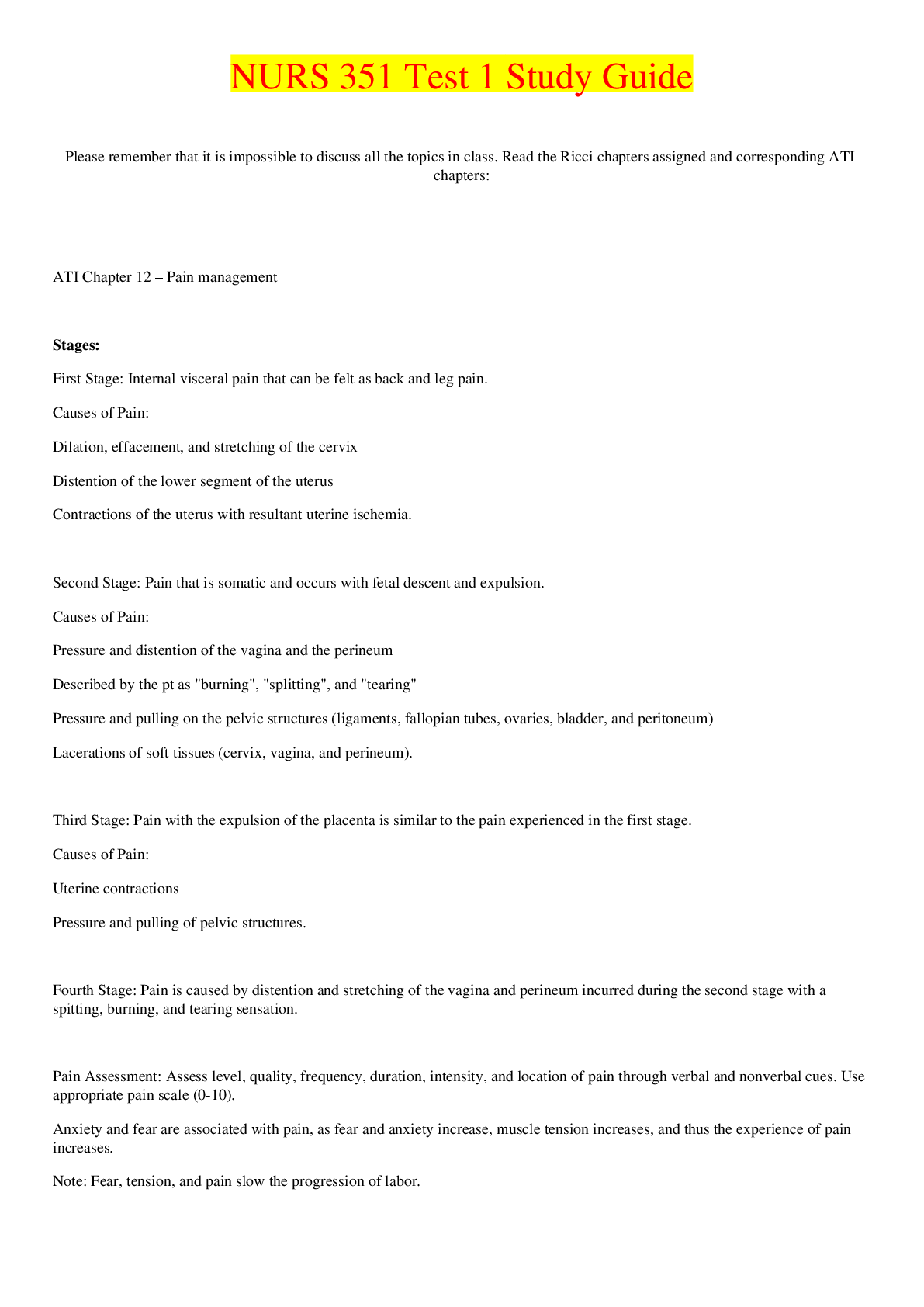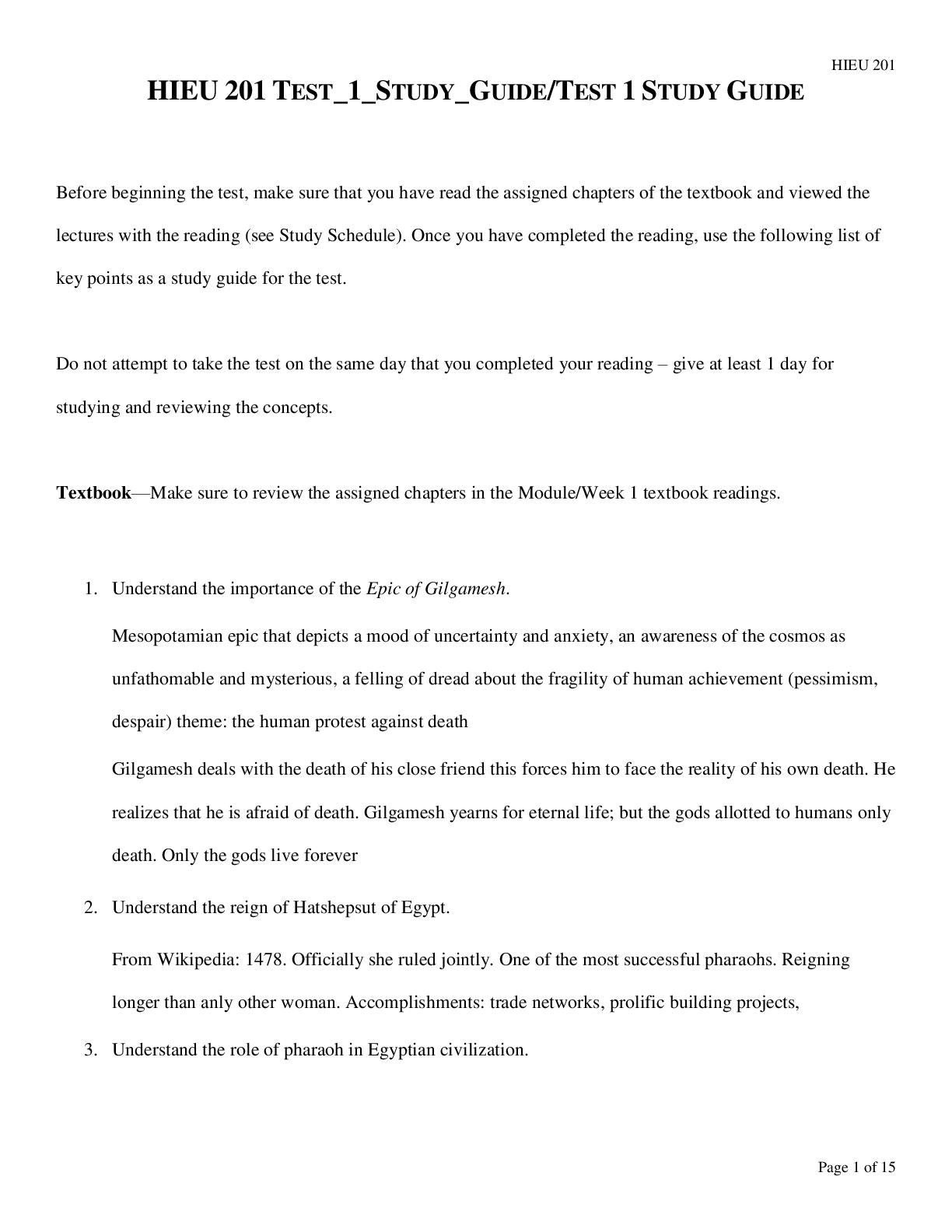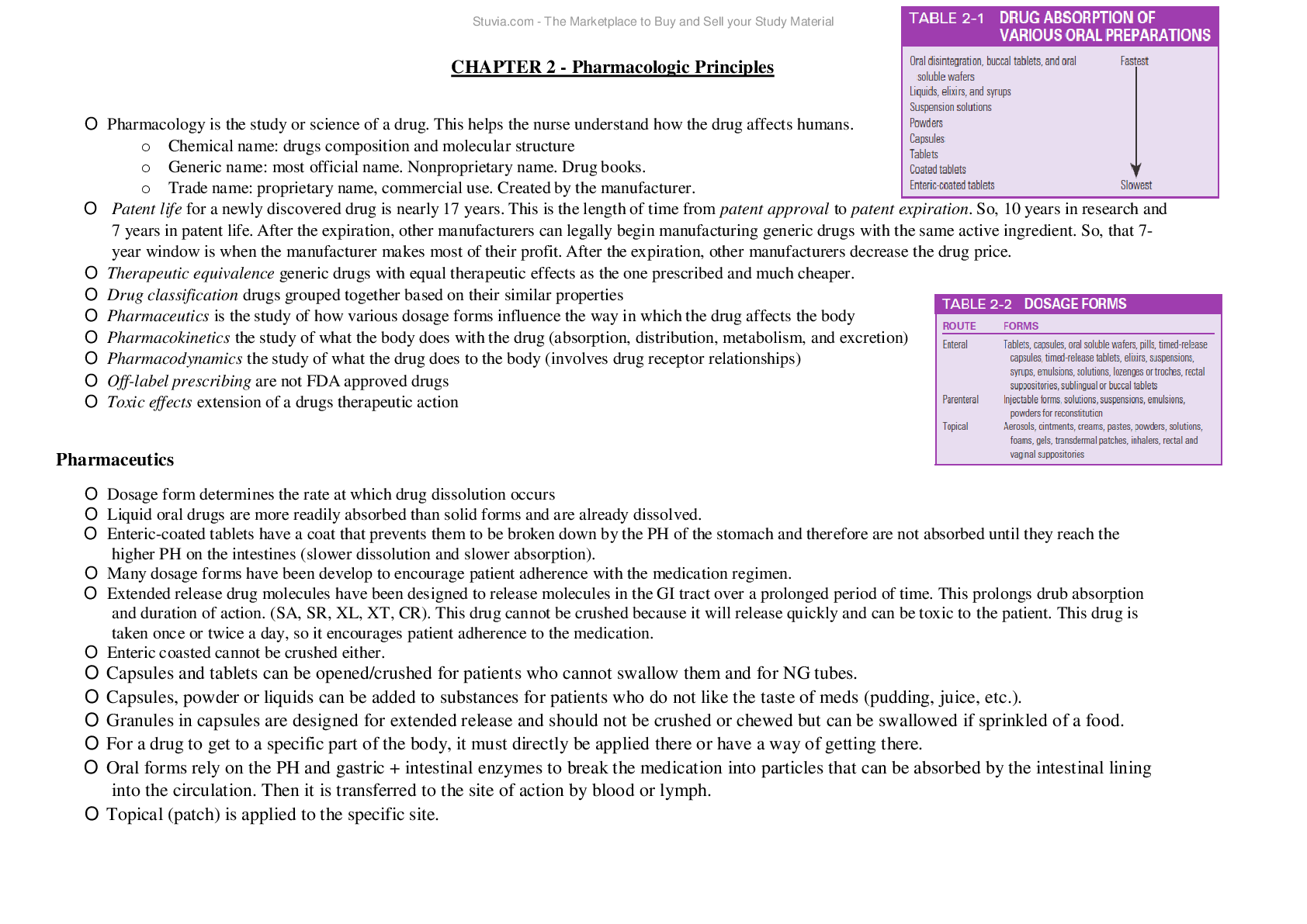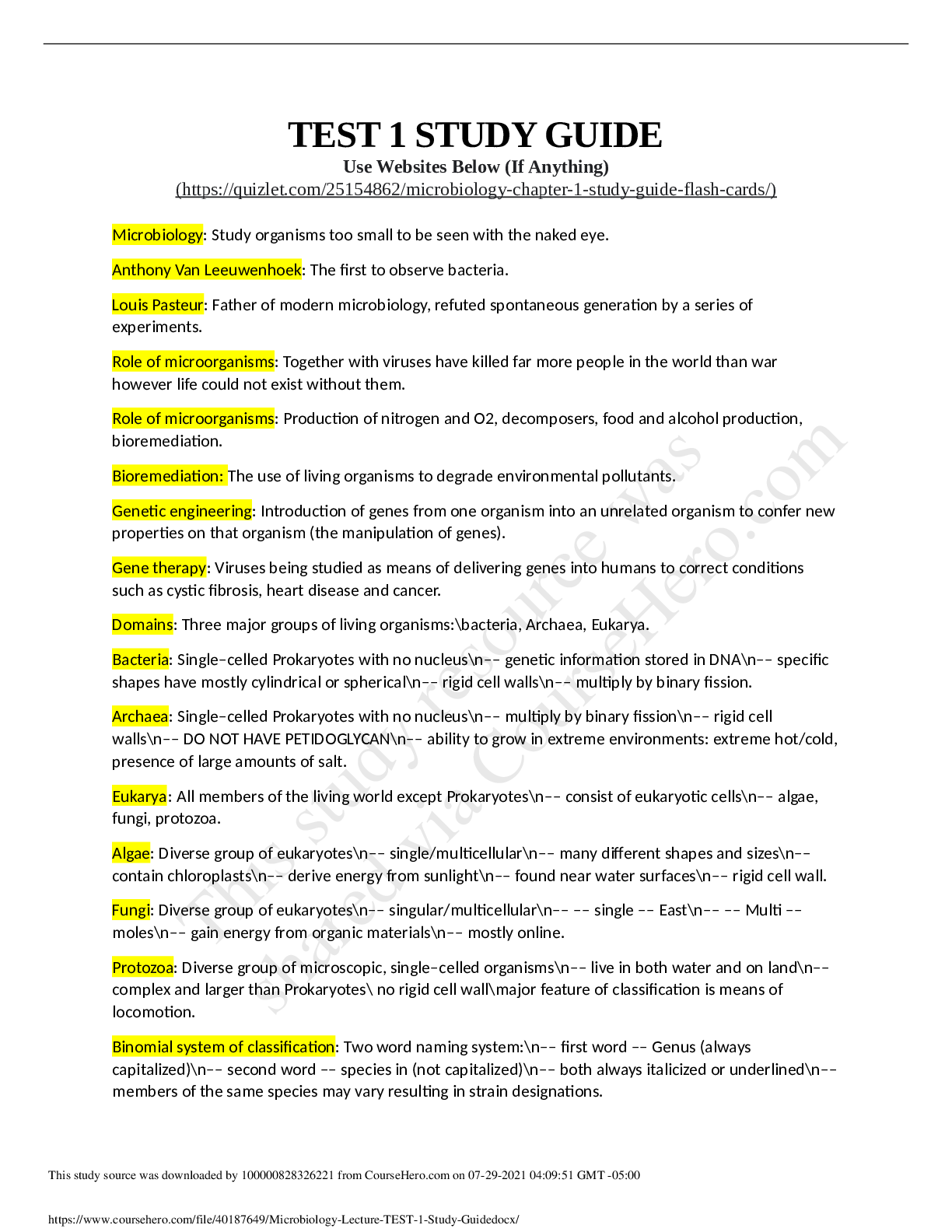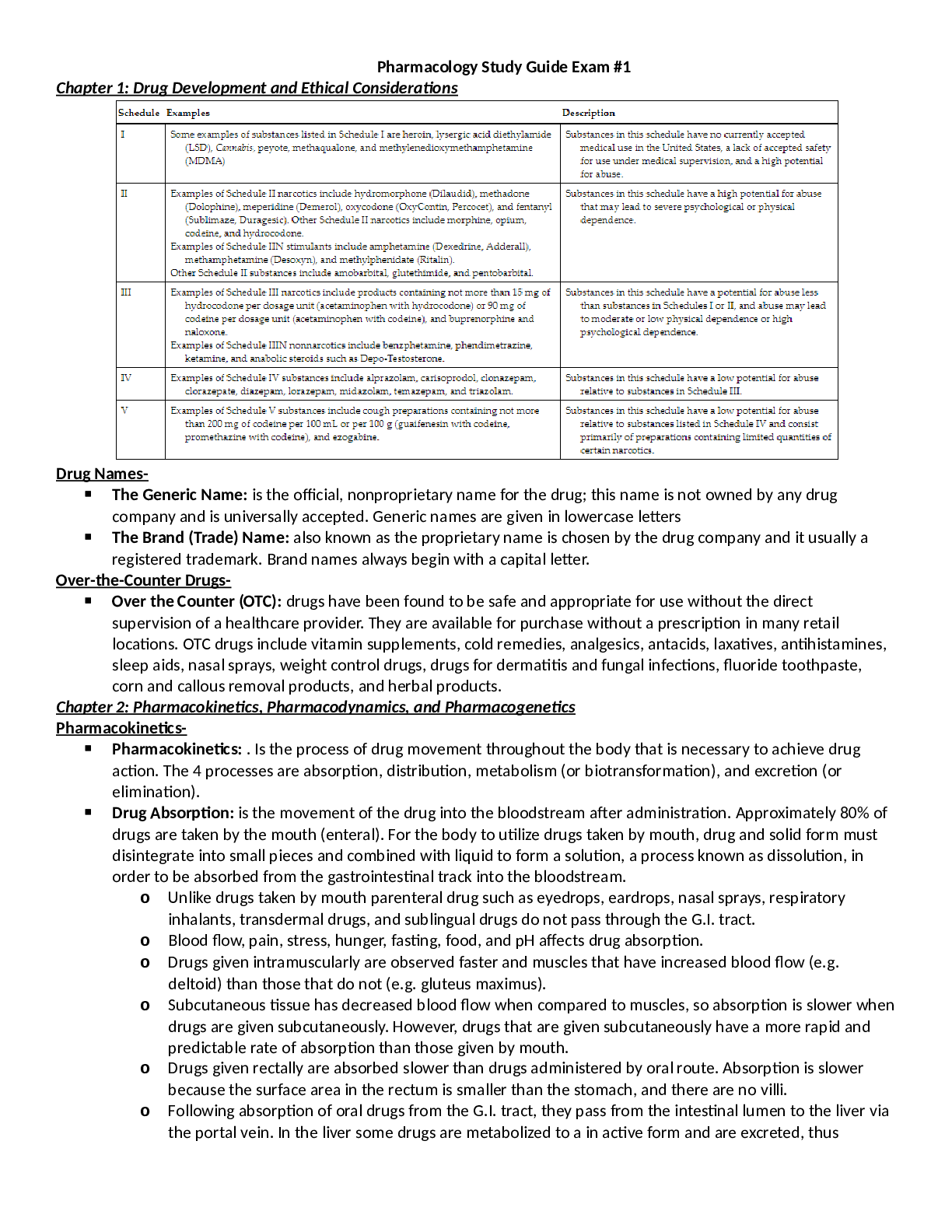*NURSING > STUDY GUIDE > NUR 1025 Test 1 Study Guide (All)
NUR 1025 Test 1 Study Guide
Document Content and Description Below
Study Guide for NUR 1025 Exam 1 1. Learning Domains and Examples a. Cognitive i. Increases a pts knowledge about a subject ii. Using written material, lecture and discussion appropriate b. Psych... omotor i. Teaches new skills to the patient ii. Giving opportunities to touch & manipulate equipment and practice skills 1. IE: learning to change a dressing over a wound c. Affective i. Education intended to change attitudes 1. IE viewing lifestyle changes for treating coronary artery disease as a positive change vs a burden 2. Teaching the Elderly a. Elderly teaching should be tailored to each patient b. Cognitive & Sensory alterations may require teaching material to be changed i. 81% of pts > 60 could not read or understand basic medication labels 3. Determining patient goals a. Incorporate patient values and beliefs b. Primary caregivers should be actively involved in care decisions c. Use interpreters to facilitate inclusion of cultural beliefs and values in care planning d. Goals should be mutually agreed upon, prioritized to patient needs i. SMART: specific, measurable, achievable, realistic, timed e. Use Nursing Interventions Classification to help determine goals 4. Types of families a. Group of people who are related by i. Heredity ii. Marriage iii. Living in the dame household b. Consists of i. Parent and children ii. Blood relatives c. Is who they say they are d. Categories: i. Nuclear Family ii. Married Parent Family iii. Extended Family iv. Married blended family v. Cohabiting parent families vi. Single parent families vii. No parent families viii. Same sex families 5. Purpose of a family assessment a. Used to measure family dynamics i. use a model that promotes health vs an illness-care model ii. a high-risk family will have illness care needs that the perinatal nurse can address while promoting the child’s health iii. Calgary Family Assessment Model: 1. 3 Major categories 2. structural, developmental and functional assessments 3. focus is on interaction of individuals within the family b. Based on i. the perspective of the nurse 1. personal and professional life experiences ii. Interactions with interviewees c. Assessment is not the truth i. Is one perspective at one point in time d. Used to i. Ask family members questions to help determine or gain an understanding of the family units with the focus being on the interaction among the individuals in the family e. Determines family roles, typical family household & structures, and dynamics in the family, especially communication methods f. Outlines patterns of daily living such as work and leisure activities g. Exposes health beliefs & practices related to disease causation, treatment of illness, folk practices, and faith healers h. Outlines extended family kinship, social networks- friends, neighbors, and significant others and their influence on health and illness i. Determines nutritional practices and how they relate to cultural factors and health 6. Assessment of the structure of a family a. Structure i. Includes determining 1. the members of the family 2. The relationship among family members 3. Context of the family ii. Ex questions: 1. Who is in the family 2. Does anyone else live with you? 3. Has anyone moved out recently? 4. Anyone who is family that doesn't live with you? b. Development i. More than concurrent development of individuals in the family ii. Family lifecycle and how the family grows and changes together c. Function i. Addresses how individuals actually behave in relation to each other ii. 2 basic aspects 1. not used to define a family's emotional health but is the family's judgement of whether they are functioning well 2. If the family is having trouble coping with instrumental issues, often expressive issues exist. 3. However, the family can cope with instrumental issues and still have expressive issues. Thus, assessment of both is essential. 4. Instrumental a. Routine activities of daily living i. Eating, sleeping, laundry, etc 5. Expressive a. Communication b. Problem solving roles c. Influence and power d. Beliefs iii. Ex questions: 1. Whose role is it to see that Granddad takes his medicine? 2. Whose turn is it to bathe Granddad? 3. Why is Jimmy not helping to take care of Granddad? 4. How can we get Jimmy to help with the caretaking? 7. Negative/dysfunctional family dynamics and factors that affect a. Evaluation is based on changes necessary based on changes observed in the dynamics of communication and interactions of the family b. Examples of factors that can affect family dynamics: i. Cancer Diagnosis ii. Intimate Partner Violence iii. Death and Dying iv. Child abuse v. Codependency (r/t family member substance abuse) vi. Interfering in-laws vii. Marital infidelity viii. Placing blame for birth of a preterm infant or for death of a young child by SIDS ix. Sibling rivalry x. Adolescent pregnancy, SIDS xi. Expanding family xii. Caregiver role changes xiii. Chronic illness xiv. Marriage, divorce, & remarriage xv. Traumatic injury/disability of a family member xvi. Aging family members xvii. End of life care 8. Anticipatory Guidance in Prenatal Care – Risk Related to Behavior (drugs/smoking/alcohol) a. Primary prevention i. Early risk assessment and promotion of healthy behaviors such as smoking cessation or reduction can lead to better pregnancy outcomes 1. Smoking/second hand smoke is associated with intrauterine growth restriction, increased perinatal and infant morbidity and mortality 2. Increased risk of spontaneous abortion, ectopic pregnancy, preterm birth, PROM, abruptio placentae, placenta previa, and fetal death. 3. Decreases placental perfusion 4. Can cause low birth weight 5. Impairs fertility, lowers age of menopause ii. Five A’s of Smoking Cessation: 1. Ask: a. Questions assess length of time smoking, how many smoked per day and how ready client is to quit. 2. Advise: a. Gives information about effects of smoking on pregnancy and fetus as well as household 3. Assess: a. Support structure, reasons for quitting/not quitting 4. Assist: a. Give support, establish a goal to quit, provide resources for quitting, education about stress reduction, follow up care 5. Arrange Follow up: a. Reassess smoking status around quit date, all prenatal visits, positive reinforcement and referrals if needed iii. Alcohol is a teratogen and can lead to fetal alcohol syndrome 1. Risks: a. Intrauterine growth restriction (IUGR) b. Increased perinatal & infant morbidity & mortality c. Neurologic developmental disabilities d. Low birth weight e. Behavioral problems, learning and physical problems f. Severe facial deformities iv. 2 nd trimester pregnancy loss (12-20weeks gestation) 1. risk increased with alcohol and caffeine use v. -use of illicit drugs, prescription drug abuse increasing across all ages & socioeconomic groups 1. -addiction: 2. -biophsychosocial disease that can lead to: a. -biogenetic predisposition b. -lack of resilience to stressful life experiences c. -poor social support 3. -abuse interferes with optimal growth and development, may lead to fetal addiction 4. -can lead to criminal charges and civil commitment in some states a. Marijuana risks: i. -readily crosses placenta ii. -increases CO levels in maternal blood, decreasing fetal oxygen supply b. Cocaine: i. Polydrug use ii. Poor nutrition iii. STIs, hepatitis B iv. Poverty v. Dysfunctional family vi. Employment difficulties vii. Stress/anger viii. Cardiovascular stress, MI, stroke ix. Liver disease x. Seizures xi. Increased risk of miscarriage, preterm labor, Small gestational age babies, abruption of placenta, malformations or stillbirth c. Opiate risks: i. 6x higher risk of pregnancy problems ii. withdrawal symptoms: 1. fetal hyperactivity 2. preterm labor 3. fetal death d. Methamphetamine: i. Increased risk of STIs, pregnancy ii. Cardiac problems, HTN, irregular heartbeat iii. Increased rate of pre-term birth, Intrauterine growth restriction, smaller head circumference e. Phencyclidine (PCP) i. Causes neurobehavioral effects to the neonate f. Hallucinogens have negative neurobehavioral effects on fetus 9. Contraception – Risk, Benefits, Use a. USES: i. Intentional prevention of pregnancy ii. Reduces risk of pregnancy iii. reduction of STIs iv. normalization of menstrual cycles b. RISKS: i. Does not always work ii. Must be used properly iii. Abstinence is only 100% effective method iv. Some methods can cause amenorrhea, spotting, increase risk of contracting HIV v. Depo-Provera contraindicated for women over 175lbs 1. Antibiotics interfere 2. Does not provide STI protection vi. IUD1. assess for copper allergy 2. not given to women who have never been pregnant due to scar tissue formation 3. No STI protection vii. Implant: 1. No STI protection viii. Sponge must be left in for 6 hrs after intercourse ix. Condoms can break, expire, slip off, or person could have a latex allergy x. Family Awareness Planning: 1. Only works for women with 26-32 day cycle 2. Woman must be aware of symptoms and track symptoms 10. Intimate Partner Violence (IPV) – Triggers/Signs and Symptoms/ a. Assess for abuse beyond the actual partner. i. Attempt to speak to pt alone b. Provide phone numbers, organization names who can assist c. Support development of a plan to leave the abusive situation d. common elements: i. -physical abuse ii. -psychologic or emotional abuse iii. -sexual assault iv. -isolation v. -control of all aspects of victim’s life 1. -money, shelter, food, time e. Triggers: i. Pregnancy can be a trigger ii. Socioeconomic status is not a factor iii. Biophysical relationship stressors iv. Male jealousy of fetus v. May be conscious or unconscious attempt to end pregnancy f. Signs & Symptoms of IPV: i. -overuse of health services ii. -vague, nonspecific complaints [Show More]
Last updated: 2 years ago
Preview 1 out of 40 pages
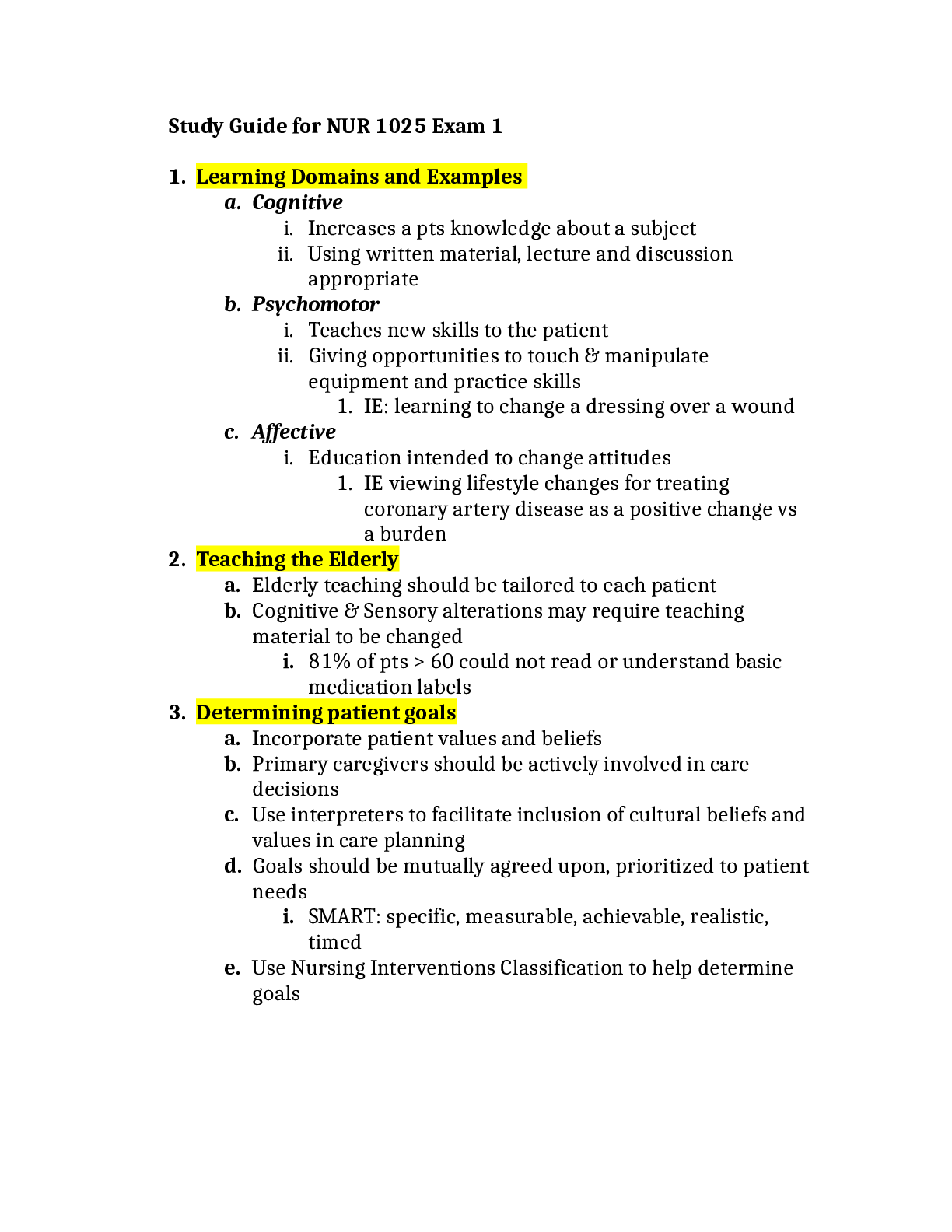
Buy this document to get the full access instantly
Instant Download Access after purchase
Buy NowInstant download
We Accept:

Reviews( 0 )
$7.00
Can't find what you want? Try our AI powered Search
Document information
Connected school, study & course
About the document
Uploaded On
Mar 25, 2021
Number of pages
40
Written in
Additional information
This document has been written for:
Uploaded
Mar 25, 2021
Downloads
0
Views
62



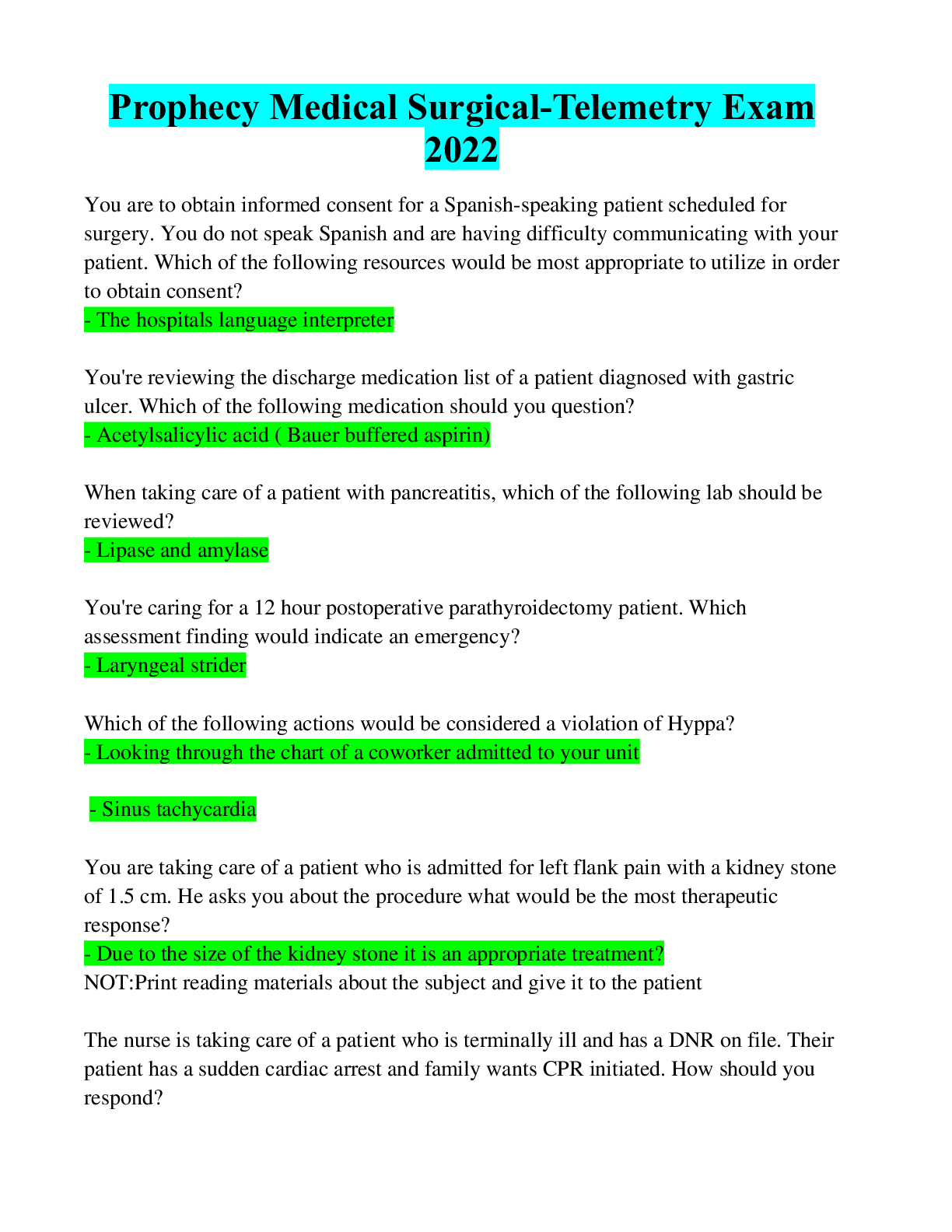


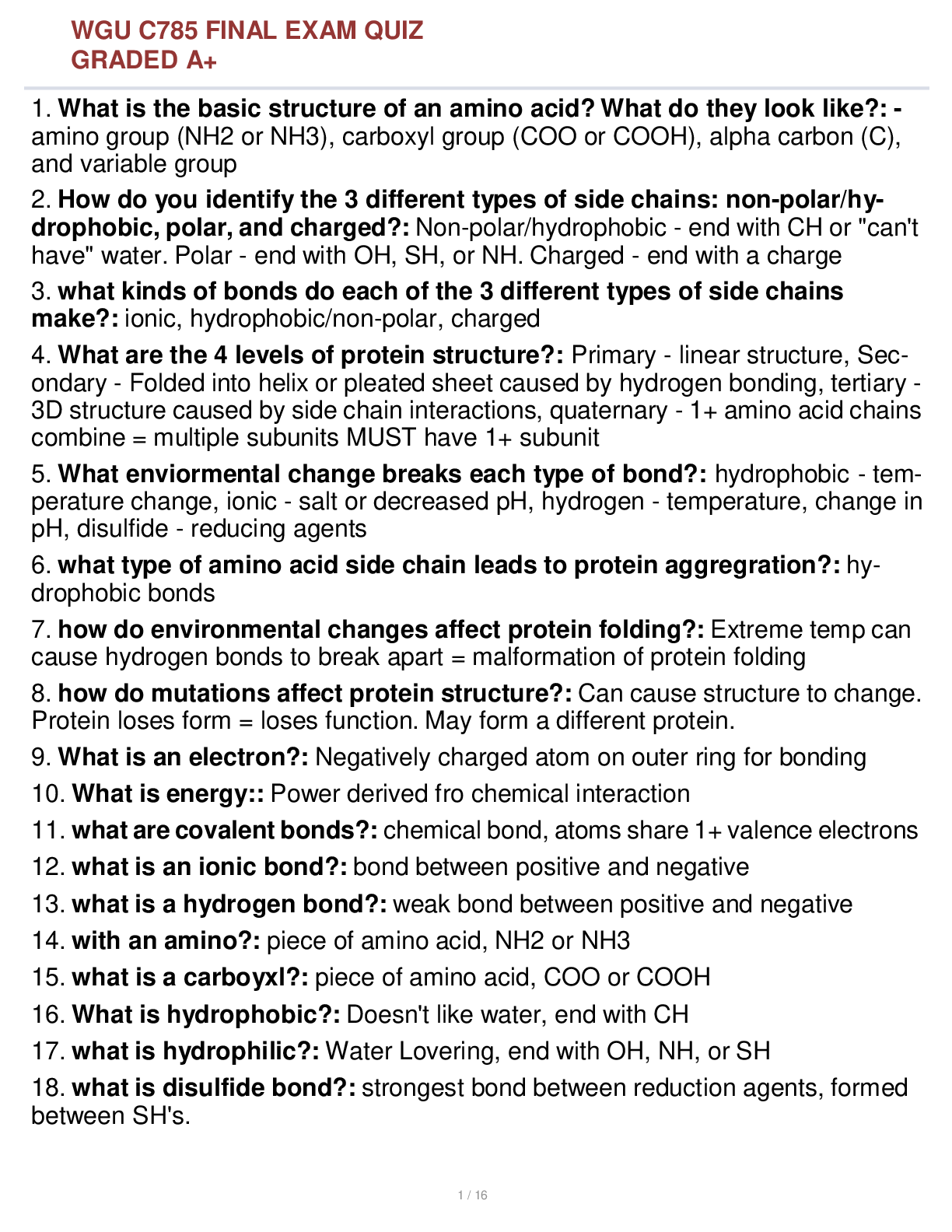
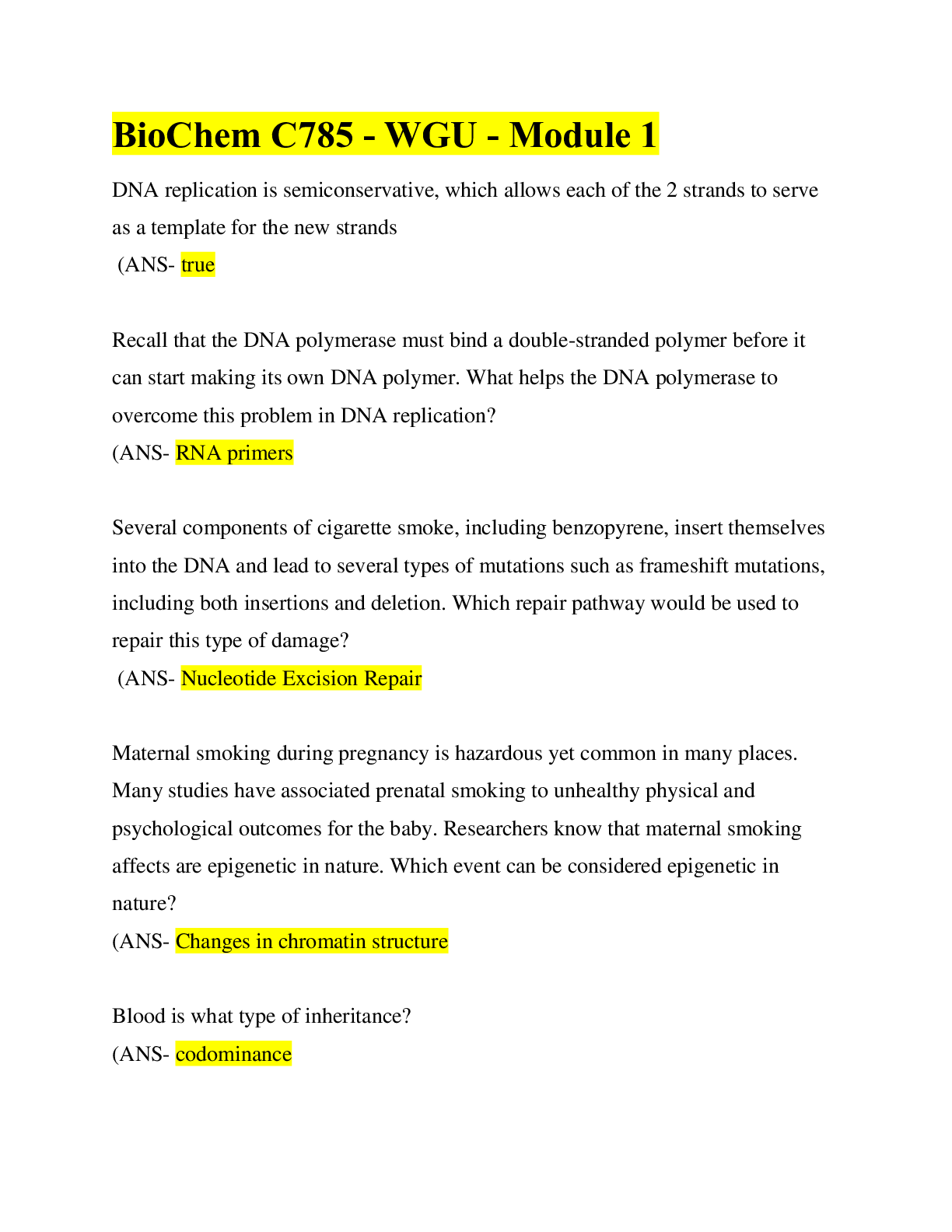
.png)

.png)


